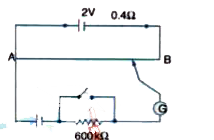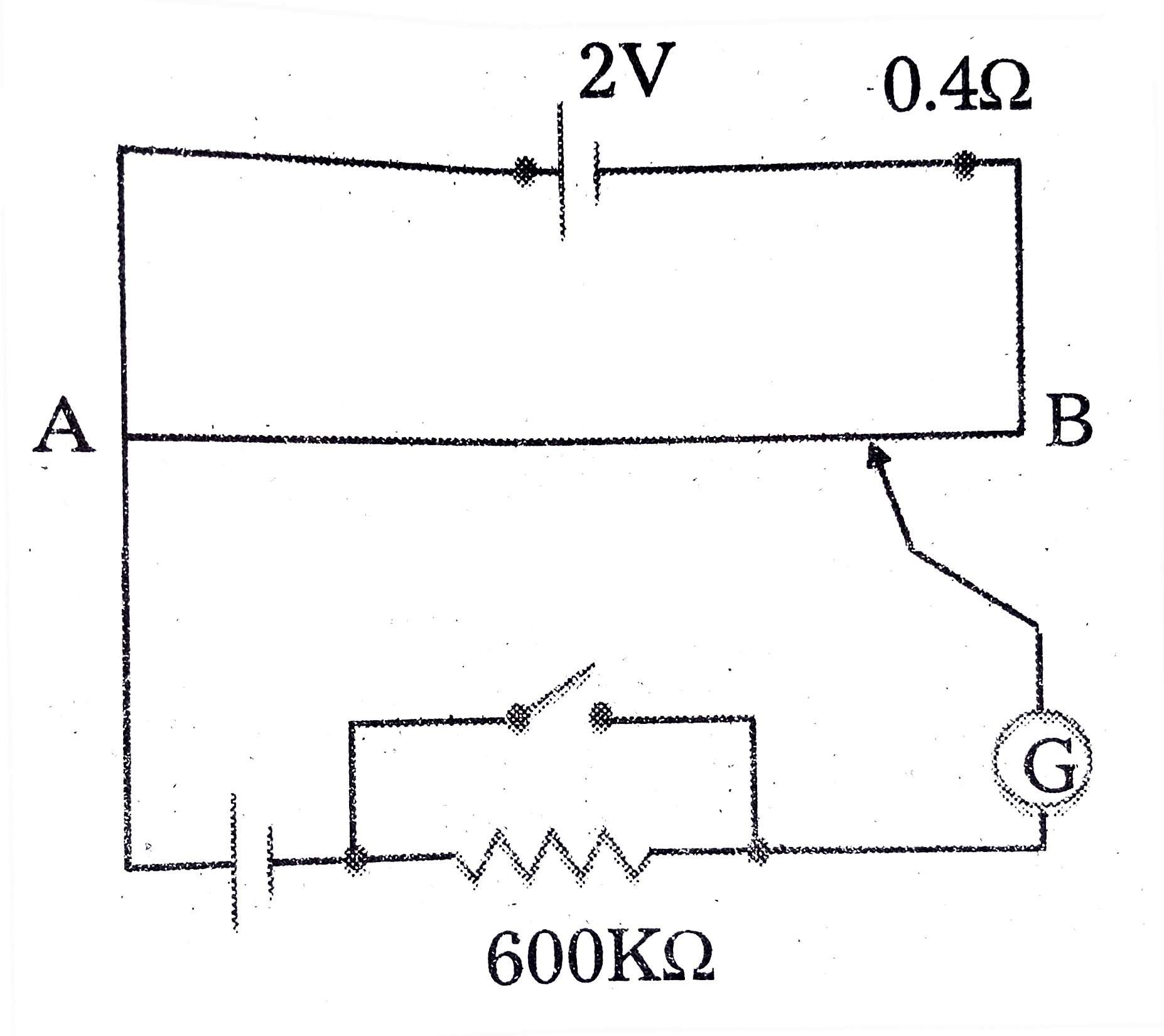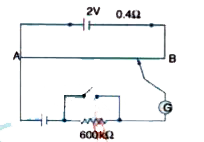Figure shows a potentiometer with a cell of 2.0 V and internal resistance 0.40 Ω maintaining a potential drop across the resistor wire AB. A standard cell which maintains a constant emf of 1.02 V (for every moderate currents upto a few mA) gives a balance point at 67.3 cm length of the wire. To ensure very low currents drawn from the standard cell, a very high resistance of 600 Ω is put in series with it, which is shorted close to the balance point. The standard cell is then replaced by a cell of unknown emf ε and the balance point found similarly, turns out to be at 82.3 cm length of the wire.

What is the value ε ?
ε=1.25V
Topper's Solved these Questions
- CURRENT ELECTRICITYBOOK - AAKASH SERIESCHAPTER - CURRENT ELECTRICITYEXERCISE - PROBLEMS (LEVEL-1)
15 Videos
- COMMUNICATION SYSTEMS BOOK - AAKASH SERIESCHAPTER - COMMUNICATION SYSTEMS EXERCISE - PRACTICE EXERCISE (TV Antenna)
16 Videos
- CURRENT ELECTRICITYBOOK - AAKASH SERIESCHAPTER - CURRENT ELECTRICITYEXERCISE - EXERCISE - III
73 Videos
Similar Questions
The colours on the resistor shown in Fig., are red orange, green and gold as read from left to right. What is the resistance of it according to colour code?

View SolutionThe height of a TV transmitting antenna is 20m. The telecast can cover a radius of
View SolutionIn a hydrogen tube it is observed that through a given cross-section 3.13×1015 electrons persec. moving from right to left and 3.12×1015 protons per sec are moving from left to right. The electric current in the discharge tube and its direction is
View SolutionFigure shows a potentiometer with a cell of 2.0 V and internal resistance 0.40Ω maintain a potential drop across the resistor wire AB. A standard cell which maintains a constant emf of 1.02 V (for very moderate currents upto a few mA) gives a balances point at 63.3 cm length of the wire. To ensure very low currents drawn from the standard cell, a very high resistance of 600Ω is put is series with it, which is shortedd close to the balance point. The standard cell is then replaced by a cell of unknown emf ε and the balance point found similarly, turns out to be at 82.3 cm length of the wire.

What is the value ε ?
View SolutionFigure shows a potentiometer with a cell of 2.0 V and internal resistance 0.40 Omega maintain a potential drop across the resistor wire AB. A standard cell which maintains a constant emf of 1.02 V (for very moderate currents upto a few mA) gives a balances point at 63.3 cm length of the wire. To ensure very low currents drawn from the standard cell, a very high resistance of 600 Omega is put is series with it, which is shortedd close to the balance point. The standard cell is then replaced by a cell of unknown emf epsilon and the balance point found similarly, turns out to be at 82.3 cm length of the wire. What purpose does the high resistance of 600 k Omega have?
View SolutionFigure shows a potentiometer with a cell of 2.0 V and internal resistance 0.40Ω maintain a potential drop across the resistor wire AB. A standard cell which maintains a constant emf of 1.02 V (for very moderate currents upto a few mA) gives a balances point at 63.3 cm length of the wire. To ensure very low currents drawn from the standard cell, a very high resistance of 600Ω is put is series with it, which is shortedd close to the balance point. The standard cell is then replaced by a cell of unknown emf ε and the balance point found similarly, turns out to be at 82.3 cm length of the wire.

Is the balance point affected by this high resistance?
View SolutionFigure shows a potentiometer with a cell of 2.0 V and internal resistance 0.40 Omega maintain a potential drop across the resistor wire AB. A standard cell which maintains a constant emf of 1.02 V (for very moderate currents upto a few mA) gives a balances point at 63.3 cm length of the wire. To ensure very low currents drawn from the standard cell, a very high resistance of 600 Omega is put is series with it, which is shortedd close to the balance point. The standard cell is then replaced by a cell of unknown emf epsilon and the balance point found similarly, turns out to be at 82.3 cm length of the wire. Is the balance point affected by the internal resistance of the driver cell.
View SolutionFigure shows a potentiometer with a cell of 2.0 V and internal resistance 0.40Ω maintain a potential drop across the resistor wire AB. A standard cell which maintains a constant emf of 1.02 V (for very moderate currents upto a few mA) gives a balances point at 63.3 cm length of the wire. To ensure very low currents drawn from the standard cell, a very high resistance of 600Ω is put is series with it, which is shortedd close to the balance point. The standard cell is then replaced by a cell of unknown emf ε and the balance point found similarly, turns out to be at 82.3 cm length of the wire.

Would the method work in the above situation if the driver cell of the potentiometer had an emf of 1.0 V instead of 2.0 V?
View Solutionचित्र में एक वोल्ट्मीटर दर्शाए गया है जिसमे एक 2.0V और आंतरिक प्रतिरोध 0.40Ω का कोई सेल वोल्ट्मीटर के प्रतिरोधक तार AB पर वोलटता पात बनाये रखता है । कोई मानक सेल जो 1.02 V का अचर विद्युत वाहक बल बनये रखता है ( कुछ mA की बहुत सामान्य धाराओं के लिए ) तार की 67.3 सेमी लम्बाई पर संतुलन बिंदु देती है । मानक सेल से अति न्यून धारा लेना सुनिश्चित करने के लिए इसके साथ परिपथ में श्रेणी 600kΩ का एक अति उच्च प्रतिरोध इसके साथ संबद्ध किया जाता है , जिसके संतुलन बिंदु प्राप्त होने के निकट लघुपथित (Shorted) कर दिया जाता है । इसके बाद मानक सेल को किसी अज्ञात विद्युत बल के सेल से प्रतिस्थापित कर दिया जाता है । जिससे संतुलन बिंदु तार की 82.3 सेमी लम्बाई पर प्राप्त होता है ।
(b ) 600kΩ के उच्च प्रतिरोध का क्या प्रयोजन है ?

View Solutionचित्र में एक वोल्ट्मीटर दर्शाए गया है जिसमे एक 2.0V और आंतरिक प्रतिरोध 0.40Ω का कोई सेल वोल्ट्मीटर के प्रतिरोधक तार AB पर वोलटता पात बनाये रखता है । कोई मानक सेल जो 1.02 V का अचर विद्युत वाहक बल बनये रखता है ( कुछ mA की बहुत सामान्य धाराओं के लिए ) तार की 67.3 सेमी लम्बाई पर संतुलन बिंदु देती है । मानक सेल से अति न्यून धारा लेना सुनिश्चित करने के लिए इसके साथ परिपथ में श्रेणी 600kΩ का एक अति उच्च प्रतिरोध इसके साथ संबद्ध किया जाता है , जिसके संतुलन बिंदु प्राप्त होने के निकट लघुपथित (Shorted) कर दिया जाता है । इसके बाद मानक सेल को किसी अज्ञात विद्युत बल के सेल से प्रतिस्थापित कर दिया जाता है । जिससे संतुलन बिंदु तार की 82.3 सेमी लम्बाई पर प्राप्त होता है ।
(d ) क्या संतुलन बिंदु चालक के सेल के आंतरिक प्रतिरोध से प्रभावित होता है ?

View SolutionFigure shows a potentiometer with a cell of 2.0 V and internal resistance 0.40 Ω maintaining a potential drop across the resistor wire AB. A standard cell which maintains a constant emf of 1.02 V (for every moderate currents upto a few mA) gives a balance point at 67.3 cm length of the wire. To ensure very low currents drawn from the standard cell, a very high resistance of 600 Ω is put in series with it, which is shorted close to the balance point. The standard cell is then replaced by a cell of unknown emf ε and the balance point found similarly, turns out to be at 82.3 cm length of the wire.

What purpose does the high resistance of 600 K Ω have ?
View SolutionFigure shows a potentiometer with a cell of 2.0 V and internal resistance 0.40 Omega maintaining a potential drop across the resistor wire AB. A standard cell which maintains a constant emf of 1.02 V (for every moderate currents upto a few mA) gives a balance point at 67.3 cm length of the wire. To ensure very low currents drawn from the standard cell, a very high resistance of 600 Omega is put in series with it, which is shorted close to the balance point. The standard cell is then replaced by a cell of unknown emf epsi and the balance point found similarly, turns out to be at 82.3 cm length of the wire. Would the method work in the above situation if the driver cell of the potentiometer had an emf of 1.0 V instead of 2.0 V?
View SolutionFigure shows a potentiometer with a cell of 2.0 V and internal resistance 0.40 Ω maintaining a potential drop across the resistor wire AB. A standard cell which maintains a constant emf of 1.02 V (for every moderate currents upto a few mA) gives a balance point at 67.3 cm length of the wire. To ensure very low currents drawn from the standard cell, a very high resistance of 600 Ω is put in series with it, which is shorted close to the balance point. The standard cell is then replaced by a cell of unknown emf ε and the balance point found similarly, turns out to be at 82.3 cm length of the wire.

Would the circuit work well for determining an extremely small emf, say of the order of a few mV (such as the typical emf of a thermo-couple)? If not, how will you modify the circuit?
View SolutionFig. shows a potentiometer with a cell of 2.0V and internal resistance 0.40Omega maintaining a potential drop across the resistor wire AB. A standard cell which maintains a constant emf of 1.02V (for very moderate currents upto a few pA) gives a balance point at 67.3 cm length of the wire. Io ensure very low currents drawn from the standard cell, a very high resistance of 600kOmega is put in series with it which is shorted close to the balance point. The standard cell is then, replaced by a cell of unknown emf e and the balance point found similarly turns out to be at 82.3 cm length of the wire, What purpose does the high resistance of 600kOmega have?
View SolutionFig. shows a potentiometer with a cell of 2.0V and internal resistance 0.40Ω maintaining a potential drop across the resistor wire AB. A standard cell which maintains a constant emf of 1.02V (for very moderate currents upto a few pA) gives a balance point at 67.3 cm length of the wire. to ensure very low currents drawn from the standard cell, a very high resistance of 600kΩ is put in series with it which is shorted close to the balance point. The standard cell is then, replaced by a cell of unknown emf e and the balance point found similarly turns out to be at 82.3 cm length of the wire,
Is the balance point affected by this high resistance?

View Solution
